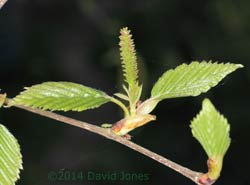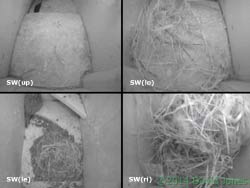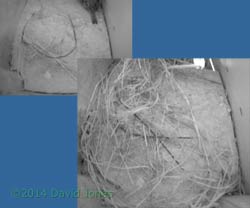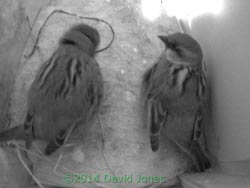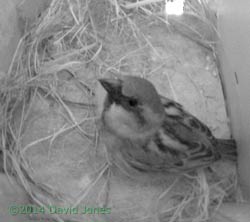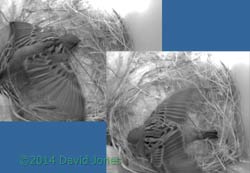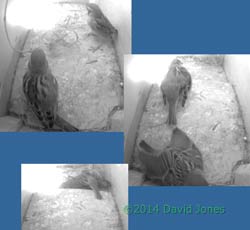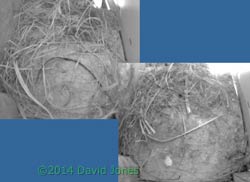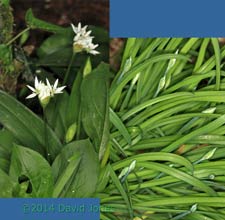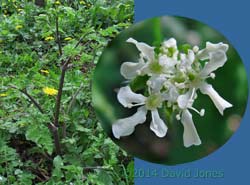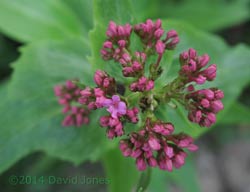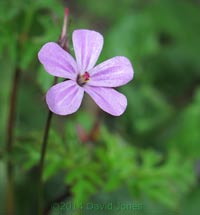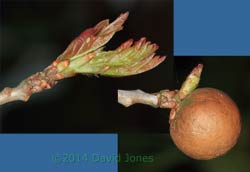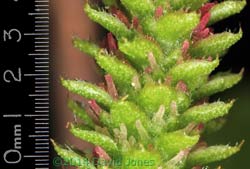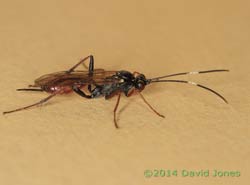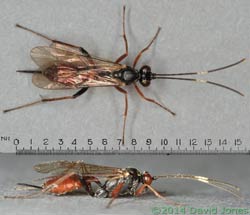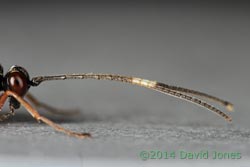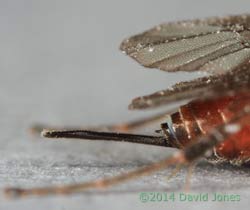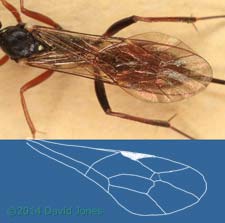Go to the last entry on this page .....Go to previous entry17 April - The last ten days seem to have passed me by like a whirlwind, with the family taking priority over the garden, diary and several jobs that I had intended to carry out! We had more time with Evan than usual, and this week he has been a very proud little boy, having the chance to wear the medal his daddy won for completing the London Marathon. Daddy was fulfilling a promise he had made on the death of Georgina, running (and walking) to raise money for Cancer Research. We have been experiencing a spell of glorious Spring weather in the lead-up to Easter, although it looks as though Easter Day itself could be a washout!
On the 14th I noticed the appearance of the first female inflorescences on the Himalayan Birch, just as the first male inflorescences were being shed by the tree. However, there is still plenty of pollen being produced to ensure a crop of seeds later in the year.
The Blackbirds are definitely nesting in the conifers once more and there has been no activity in either of the monitored sites since my last report. Just to add to the frustration I believe that the Robins are now nesting in the log store shelter, just a couple of feet away from the incomplete Blackbird nest. However, the Robins have chosen a well hidden spot behind a section of lattice panel, well away from any possibility of a camera being used to watch them. Instead, I'm turning my attention to the Swift boxes. The cameras are now on and reveal one completed Sparrow nest in box SW(ri), and in SW(lo) another Sparrow pair are in the early stages of building. The picture shows the set of images that I'm recording at the moment (and captured at 10pm). There is no daytime activity in either SW(up) or SW(le) but there are Sparrows roosting in both tonight, although the one in SW(up) is out of sight at the top of the frame.
As is usually the case with Sparrow nests, a dome of straw prevents us from seeing what is going on in SW(ri), apart from slight movements when a bird enters or leaves. In SW(lo) the Sparrows have only just begun their nest building. A few bits of straw were brought in yesterday, and the upper image shows the state of the box at 6am today. The main image was captured just after 7pm.
Both partners have been active during the day,
although I got the impression that I saw the male more often than the female,
and there was certainly quite a lot of shuffling going on, I think by both, although I haven't had the time to go through the recording to confirm things.
What I have finally got around to doing is to set up the webcam, which will monitor these Sparrows as long as possible. While the webcam will be running 24/7, for the moment activity will only be seen during daylight hours. When the Swifts return it is very likely that the Sparrows in SW(ri) will be evicted. On the other hand, SW(lo) has not hosted nesting Swifts so far so there is a possibility that the nest building there will not be in vain - if that is the case then it will be fingers crossed that the Sparrows do not construct a thick dome to block the view....
19 April - A largely bright, sunny day, but with a constant south-easterly breeze that made it feel quite chilly at times.
While this pair were in SW(up) there were no birds in SW(lo), and vice versa. This left me wondering if it was the same pair considering an alternative nest site. Our grand-daughters spent several hours here today and had the chance to see the Sparrows in action for the first time.
Anyway, by the end of the day it looked as though yesterday's progress in SW(lo) had suffered a bit of a reversal, with straw being moved back towards the entrance.
A trio of new flowerings to report on today -
First, deep under the cover of the Hawthorn the first of the Wild Garlics (Ramsons) have flowered (left hand image). Since they were introduced to that spot in the garden they have started popping up in numerous spots. I see that one plant right next to the remains of the Ivy tree is also about to flower. The Triangular-stalked Garlics (right) seem to be a couple of days away from their flowering.
A couple of weeks ago I commented on how the Hedge Parsley plants were no more than ground cover. Well, they are now between 50 - 70cm tall, and their flowers started opening today.
And the third of the new flowers belongs to a Red Valarian plant. By the end of the day just this one small flower had opened.
I need to go back to the beginning of the week (the 14th) which is when I saw flowers on the Herb Robert plants for the first time this Spring. And their presence helped me (and our grandson) to see our first Bee-fly of 2014! I haven't seen another one all week.
The last of our trees is now coming into leaf - our Oak tree (in a large pot). The first of its buds started to burst today. The tree itself is now around 1.75m tall. I've also included a picture of its first marble gall, produced as a reaction to the laying of eggs by andricus kollari (the Oak marble gall wasp). The gall has a diameter of about 12mm.
This afternoon I took a closer look at one of the female inflorescences on our Birch. In this image you can see the stigmas (colour varying from red to cream) protruding in readiness to catch wind-blown pollen.
20 April - As was forecast, we had rain today. The morning started dry but by 10am we had the first light shower. As lunchtime approached the showers merged and in the afternoon we had some heavy rain. By 6pm the skies were clearing, and tonight stars are visible despite a scattering of thin, high cloud. For us it was a quiet day during which we could relax between doing various grandchild related jobs (such as servicing a submarine motor!). Having said that, a visitor to our bathroom meant a photographic session. This is an Ichneumon fly, although my first attempts to identify the species have failed.
Including is antennae and ovipositor, it measures just over 15mm in length.
The antennae are just over 6mm long and are made up of at least twenty five segments, all dark brown apart from a band of three that are white.
At the rear end of its abdomen it has an ovipositor (and its protective sheath) that is about 1.8mm in length. Ichneumon flies are parasitic insects and usually lay their eggs in the larvae of other insects by piercing their skin with the ovipositor.
Here I've attempted to trace the vein pattern in a forewing. The resulting sketch shows a pattern characteristic of the Ichneumons.
As for the Sparrows, despite the wet wet weather there has been some limited activity in both SW(up) and SW(lo), but with no more than two birds visible at any one time I still suspect that it is the same pair moving between the two boxes. I switched the webcam over to SW(up) this morning as that appeared to be the most active box, with some shuffling going on. I didn't see this behaviour in SW(lo) today.
21 April - Very pleasant and warm for much of the day before the skies became overcast in the late afternoon. This evening it is drizzling and there is the prospect of some heavy rain overnight. Just a brief entry this time. It looks as though the Sparrows have been spending more time in SW(lo) than SW(up) today and I switched the webcam over to follow the former box once more. Over the last couple of days the camera in the House Martin box 2 has been suffering from an intermittent bad connection so today I set about tracing the fault. Having ruled out any problems in our loft I headed up a ladder to the boxes themselves. The fault itself was soon sorted out, and then I set about doing a bit of 'house-keeping'. The camera lenses were rather dirty so I cleaned them, and then I set about clearing away some of the dirt and cobwebs in the space above the three nests. Included were some quite tough veils of silk that extended across behind the camera mounts, and as I cleared these I came across a quite unexpected first for the garden, a large example of what I believe is the spider Steatoda nobilis, commonly referred to as the False Widow Spider. While the common name suggests a link to the Black Widow Spider they actually belong to a different genus. While not poisonous in the way the Black Widow is, these spiders can pierce human skin and inflict a sometimes painful bite with symptoms similar to a bee sting. I soon found a second, slightly smaller example. The larger individual measures around 13mm in length close to the maximum of 14mm) and the other is 11mm long. Both are females - I wasn't able to find a male. Both spiders are now in temporary captivity until I have time to photograph them, probably the day after tomorrow.
I still need to start to catch up with the large images for the entries since March 26. Also I would like to set up the nest box diary. A quiet couple of hours during the holiday is called for!
Click on images to see larger version
|
|
